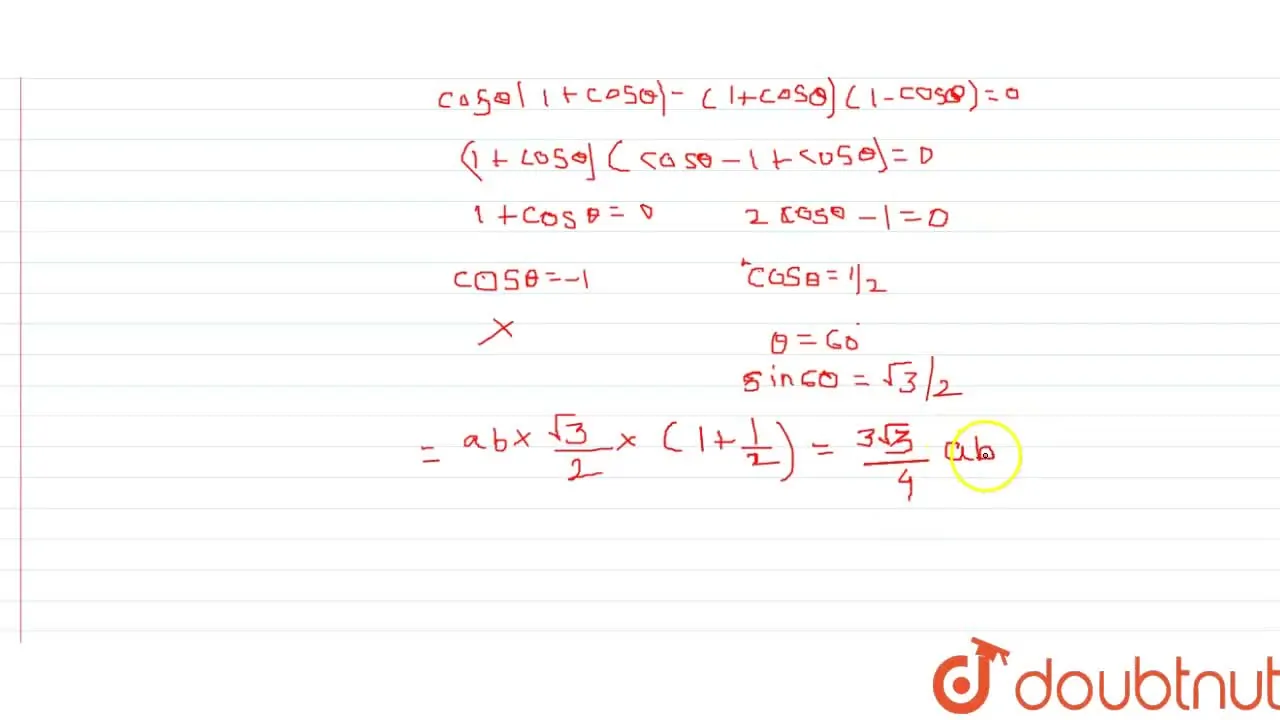Find the area of the greatest isosceles triangle that can be inscribed in the ellipse (x2a2)+(y2b2)=1 having its vertex coincident with one extremity of the major axis.
Consider the isosceles triangle ABC:
A(a,0),B(acosθ,bsinθ)andC(acosθ,−bsinθ)
Area of △ABC=12×BC×heightof△ABC
Height of △ABC=a(1+cosθ)
BC=2bsinθ
or, triangle=12×2bsinθ×a(1+cosθ)=ab(sinθ)(1+cosθ)
For maximum area of the triangle,
d(△)d(θ)=abcosθ(1+cosθ)−ab(sin2θ)=0
or, cosθ(1+cosθ)−sin2θ=0
or, cosθ(1+cosθ)−(1+cosθ)(1−cosθ)=0
or, (1+cosθ)(cosθ−1+cosθ)=0
or,(1+cosθ)(2cosθ−1)=0
or, cosθ=−1or,cosθ=12
For maximum value, we take
cosθ=12 and sinθ=√32
or, Maximum area =ab×√32(1+12)=3√34ab
Related Playlists
- BOOK - NCERT ENGLISHCHAPTER - APPLICATION OF DERIVATIVESEXERCISE - EXERCISE 6.49videos
APPLICATION OF DERIVATIVES
- BOOK - NCERT ENGLISHCHAPTER - APPLICATION OF DERIVATIVESEXERCISE - EXERCISE 6.529videos
APPLICATION OF DERIVATIVES
- BOOK - NCERT ENGLISHCHAPTER - APPLICATION OF INTEGRALSEXERCISE - EXERCISE 8.27videos
APPLICATION OF INTEGRALS
Similar Questions
Find the area of the greatest rectangle that can be inscribed in an ellipse x2a2+y2b2=1.
View SolutionFind the area of the greatest rectangle that can be inscribed in an ellipse x2a2+y2b2=1
View SolutionAn isosceles triangle that can be inscribed in an ellipse x2a2+y2b2=1 having its vertex coincident with one extremity of major axis has the maximum area equal to m√n4ab (m,n are prime numbers) then m2−n3=
View SolutionThe area of the ellipse x2a2+y2b2=1 is
View SolutionFind the area enclosed by the ellipse x2a2+y2b2=1.
View SolutionFind the maximum area of an isosceles triangle inscribed in the ellipse x2a2+y2b2=1with its vertex at one end of the major axis.
View SolutionFind the equation of the largest circle with centre (1, 0) that can be inscribed in the ellipse x2+4y2=16
View SolutionThe dimension of the rectangle of maximum area that can be inscribed in the ellipse (x/4)2+(y/3)2=1 are
View SolutionFind the locus of the vertices of equilateral triangle circumscribing the ellipse x2a2+y2b2=1.
View SolutionIf A be the area of the largest circle with centre (1,0) that can be inscribed in the ellipse x2+4y2=16, then 945πA=.
View Solution


